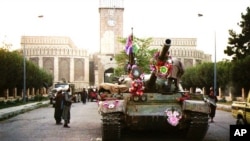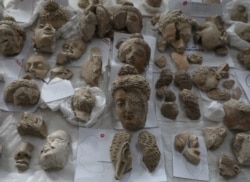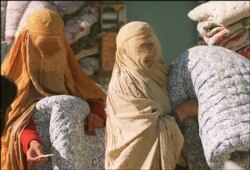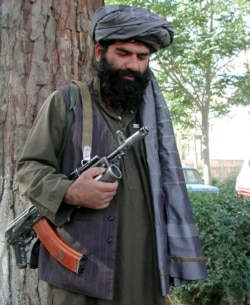Editor's note: The U.S. departure from Afghanistan marks another major turning point for the Taliban, the militant group with a long history in Afghanistan and a complex relationship with Pakistan. VOA reporters are looking back at the Taliban's rise to power and the group's previous tenure as Afghanistan's rulers.
In late September 1996, after four years of civil war in Afghanistan, the Taliban succeeded in capturing Kabul and then tortured and killed former President Mohammad Najibullah before hanging his body from a traffic post.
Shocking images of the executed president sent a signal to Afghans and the world that the Taliban had taken charge and would be imposing what they called a "complete Islamic system" for Afghanistan. Taliban flags began flying over government offices in Kabul, and their military rivals fled to their strongholds in the north.
I arrived in Kabul on October 29, the start of the Taliban's second month in power in the war-torn city. The so-called "moral police" of the Taliban government agency known as the Promotion of Virtue and Elimination of Vice were the most feared squads in the capital. The armed guards in traditional Afghan dress had, in a single month, forced quick changes on urban Afghan women and men. Every man had to wear a cap or turban and sport a beard long enough to be grabbed by a fist. During prayer times, all businesses were required to close.
The old-fashioned burqa, a mostly blue shuttlecock-shaped covering, was imposed on women. They were beaten with batons in public by the Virtue and Vice squads, sometimes for unknown reasons. Later they would find out that their ankles had been visible to men, or that they had been seen talking to a stranger. The Taliban would beat a woman if she was not accompanied by a mahram, a male member of the family with whom marital relations are considered haram (forbidden). Seeing Taliban beating women on Kabul streets became the new normal.
Schools closed, televisions were smashed, ancient relics at the Kabul Museum went missing, pictures and portraits of humans and animals in official buildings were torn into pieces.
Music was banned, so the sounds of chirping birds replaced the traditional instrumental music of Afghan drums and rabab (a local variant of guitar). Local music was replaced by the Taliban's jihadi taranas (anthems) and sermons, heard on Radio Sharia, the new name of Afghanistan's national radio and television.
Imposing official
The Taliban intensified the public's fear by appointing the radical madrassa graduate Mullah Qalamuddin as deputy minister of the Virtue and Vice ministry. A graduate of the Darul Uloom Haqqania madrassa in Akora Khatak, Pakistan, where many Taliban leaders studied, Mullah Qalamuddin was an imposing official who had a reputation for personally leading the group's fear campaign. He was over 6 feet (1.8 meters) tall, and when I met him at his ministry's building, he used a love seat as his office chair as he directed his subordinates. He had only contempt for those who expressed concerns over women rights, saying that a woman has two abodes: a home and a grave.
Kabul's landmarks at the time bore signs of the Taliban's harsh views. At the city's multistory Intercontinental Hotel, staff told visiting journalists about Mullah Qalamuddin getting angry when he had seen a small statue of Buddha in one of the halls of the hotel. He used an ax to smash it to pieces.
At the Afghan national bank building in downtown Kabul, where many women had worked, the top floor had been converted into a child care facility. But the bank was now closed, and the women had all been banished once the Taliban took power, leaving a floor strewn with empty cradles, pacifiers and toddlers' toys. The bank's civilian guardians, during a Taliban-escorted visit to the building, said they had no plan in place to reopen. Many other businesses and nongovernment organizations ended up losing all their female staffers, who had been banned from working under the Taliban's puritan Sharia.
At the time, the Taliban's founding leader, Mullah Mohammad Omar, was running Kabul remotely from his southern stronghold Kandahar, then an 18-hour drive away. There was not much of an administrative state. His six-member high council led by Mullah Mohammad Rabbani, a former leader from Kandahar, had little say in making decisions.
Broadcast messages
For locals trying to understand their new leaders' rapid changes, the international Pashto-language broadcasters VOA and BBC and the Taliban's Radio Sharia were the main sources of information.
Radio Sharia taught them how to tailor themselves under the new Islamist laws of Taliban. The mullahs, graduates from Pakistani madrassas, were offering a menu of punishments in their sermons during primetime evening broadcasts.
Some of the messages warned people of the new social restrictions: "Satan urinates on the head of a woman who is not covering her head." "God will pour hot lead into the ears of those who listen to music." "Walking or driving on the left side of the road is un-Islamic." "A man looking at a woman or vice versa is the fornication of eyes."
Kabul was more tense at night. In the evenings, new warnings were broadcast via Radio Sharia, and Taliban fighters enforced a daily dusk-to-dawn curfew, patrolling the streets in pickup trucks. These nighttime patrols led to rumors of mass arrests or Taliban troop movements for northern battle lines. Some Kabul locals thought the Taliban were bringing in Pakistani fighters under the cover of night. At the start of the Taliban's reign in Afghanistan, people in Kabul were already angry with Islamabad, believing that Pakistan's support for the Taliban was undermining Afghans.
Pakistani officials at the time encouraged this perception. In Pakistan, the then interior minister and former army general, Naseerullah Babar, was not shy of being called the "architect of Taliban" in Afghanistan. He would take credit for helping to create the Afghan Taliban throughout his retired life.
Pakistan's perceived role
I left Kabul for Kandahar, along with a Western journalist, on November 5, 1996. At the time, the drive was rough and around 480 kilometers long, and the needle on the speedometer rarely crossed 30 kilometers per hour. On the way, a radio bulletin brought news from Pakistan, saying the president had dismissed Prime Minister Benazir Bhutto and dissolved her elected government over corruption allegations. That marked the second time that her government had been dismissed by a sitting president in Pakistan.
Bhutto's first term ended over a costly military miscalculation in Afghanistan. In early 1989, her government directed pro-Pakistan Afghan fighters to try to take over Afghanistan's eastern city of Jalalabad from the country's Soviet-backed government. The operation was a debacle, and the plot was exposed, becoming a political liability for her government and contributing to the perception that Pakistan backs militants in Afghanistan as part of its foreign policy strategy.
Pakistan's next government, that of Prime Minister Nawaz Sharif, solidified that perception in 1997 by becoming the first to officially recognize the Afghan Taliban government. Twenty-four years later, despite years of denials from Islamabad, most Afghans still see the Taliban as an arm of the Pakistani state.












